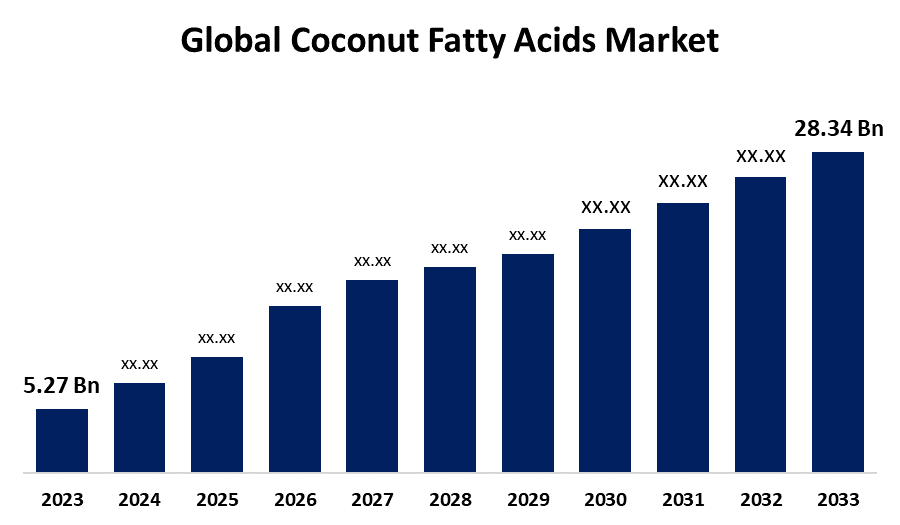Global Coconut Fatty Acids Market Size, Share, and COVID-19 Impact Analysis, By Type (White Coconut Fatty Acids, Whole Coconut Fatty Acids, and Others), By Function (Additives, Emulsifier, Lube, and Others), and By Region (North America, Europe, Asia-Pacific, Latin America, Middle East, and Africa), Analysis and Forecast 2023-2033
Industry: Chemicals & MaterialsGlobal Coconut Fatty Acids Market Insights Forecasts to 2033
- The Global Coconut Fatty Acids Market Size Was Estimated at USD 5.27 Billion in 2023
- The Market Size is Expected to Grow at a CAGR of around 18.32% from 2023 to 2033
- The Worldwide Coconut Fatty Acids Market Size is Expected to Reach USD 28.34 Billion by 2033
- North America is Expected to Grow the fastest during the Forecast Period.

Get more details on this report -
The Global Coconut Fatty Acids Market Size is Expected to Cross USD 28.34 Billion by 2033, Growing at a CAGR of 18.32% from 2023 to 2033.
Market Overview
The global coconut fatty acids market refers to the industry that produces, distributes, and consumes fatty acids produced from coconut oil. These fatty acids are widely employed in a variety of industries, including personal care, cosmetics, food and beverages, and industrial applications, thanks to their emollient, cleaning, and surfactant qualities. The market is being pushed by rising demand for natural and sustainable components in consumer products, as well as the increased use of coconut-derived fatty acids in detergents, soaps, and medicines. Furthermore, increased awareness of environmental sustainability is encouraging manufacturers to use eco-friendly raw materials in detergents, soaps, and industrial applications. The expanding food and beverage industry, particularly in the development of plant-based and clean-label products, presents promising growth opportunities. Furthermore, advancements in extraction and processing technologies, as well as increased investment in R&D, are expected to improve product quality and broaden application areas, thereby driving market opportunities.
Report Coverage
This research report categorizes the coconut fatty acids market based on various segments and regions forecasts revenue growth and analyzes trends in each submarket. The report analyses the key growth drivers, opportunities, and challenges influencing the coconut fatty acids market. Recent market developments and competitive strategies such as expansion, type launch, development, partnership, merger, and acquisition have been included to draw the competitive landscape in the market. The report strategically identifies and profiles the key market players and analyses their core competencies in each sub-segment of the coconut fatty acids market.
Global Coconut Fatty Acids Market Report Coverage
| Report Coverage | Details |
|---|---|
| Base Year: | 2023 |
| Market Size in 2023: | USD 5.27 Billion |
| Forecast Period: | 2023-2033 |
| Forecast Period CAGR 2023-2033 : | 18.32% |
| 2033 Value Projection: | USD 28.34 Billion |
| Historical Data for: | 2019-2022 |
| No. of Pages: | 210 |
| Tables, Charts & Figures: | 110 |
| Segments covered: | By Type, By Function, By Region and COVID-19 Impact Analysis |
| Companies covered:: | Wilmar International Ltd., Cargill, Incorporated, KLK OLEO, Mewah Group, Vantage Specialty Chemicals, Inc., The Good Scents Company, Musim Mas Holdings, Godrej Industries Ltd., Royal Coconut Company, PT. Energi Sumber Bumi, and other key vendors. |
| Pitfalls & Challenges: | COVID-19 Impact, Challenges, Future, Growth, & Analysis |
Get more details on this report -
Driving Factors
Several key factors drive the global coconut fatty acids market, including rising demand for natural and plant-based ingredients in personal care, cosmetics, and household products. The growing awareness of the health benefits of coconut-derived fatty acids, such as their antimicrobial and moisturizing properties, is also driving market expansion. Furthermore, due to stricter environmental regulations, manufacturers are increasingly turning to coconut-based fatty acids. Another important driver is the growing industrial sector, particularly in rubber and plastics manufacturing, where fatty acids are used as processing aids. Furthermore, the steady growth of the food and beverage industry, which uses coconut fatty acids as emulsifiers and preservatives, is helping to drive market expansion.
Restraining Factors
The global coconut fatty acids market faces constraints such as fluctuating raw material prices caused by variations in coconut production, which can have an impact on supply stability. Limited availability of coconuts in certain regions, as well as reliance on specific tropical countries, create supply chain challenges. Furthermore, the presence of alternative plant-based and synthetic fatty acids increases competition, which affects market growth. Strict environmental and regulatory policies for sourcing and processing may also impede growth and raise production costs.
Market Segmentation
The coconut fatty acids market share is classified into type and function.
- The white coconut fatty acids segment held the greatest share in 2023 and is anticipated to grow at a significant CAGR during the forecast period.
Based on the type, the coconut fatty acids market is divided into white coconut fatty acids, whole coconut fatty acids, and others. Among these, the white coconut fatty acids segment held the greatest share in 2023 and is anticipated to grow at a significant CAGR during the forecast period. This growth is primarily driven by their widespread use in household cleaning products, as well as textile chemicals, fiber lubricants, and personal care products such as body washes and shampoos. The growing consumer preference for natural and sustainable ingredients in these industries drives up the demand for white coconut fatty acids.
- The emulsifier segment accounted for the majority of the share in 2023 and is estimated to grow at a remarkable CAGR during the projected timeframe.
Based on the function, the coconut fatty acids market is divided into additives, emulsifier, lube, and others. Among these, the emulsifier segment accounted for the majority of the share in 2023 and is estimated to grow at a remarkable CAGR during the projected timeframe. This dominance is primarily due to the widespread use of coconut fatty acids as emulsifying agents in personal care and cosmetic products like shampoos, conditioners, soaps, and lotions, which improve texture and stability. The growing consumer preference for natural and sustainable ingredients in these products fuels demand.
Regional Segment Analysis of the Coconut Fatty Acids Market
- North America (U.S., Canada, Mexico)
- Europe (Germany, France, U.K., Italy, Spain, Rest of Europe)
- Asia-Pacific (China, Japan, India, Rest of APAC)
- South America (Brazil and the Rest of South America)
- The Middle East and Africa (UAE, South Africa, Rest of MEA)
Asia Pacific is anticipated to hold the largest share of the coconut fatty acids market over the predicted timeframe.

Get more details on this report -
Asia Pacific is anticipated to hold the largest share of the coconut fatty acids market over the predicted timeframe. The region benefits from abundant coconut production, especially in Indonesia, the Philippines, and India, which ensures a consistent supply of raw materials. This robust production capacity enables the manufacture and export of coconut-derived products, including fatty acids. Furthermore, rising consumer demand for natural and sustainable products in the Asia Pacific region drives market growth. Coconut fatty acids are commonly used in personal care and cosmetic products because of their moisturizing and conditioning properties. As people become more aware of the health benefits of coconut-derived products, such as their antioxidant and antimicrobial properties, they are being used in a variety of food, pharmaceutical, and personal care products.
North America is expected to grow at the fastest CAGR growth of the coconut fatty acids market during the forecast period. There is a significant shift toward natural and sustainable products, particularly in personal care and cosmetics, as consumers prefer plant-based ingredients that have health and environmental benefits. Coconut fatty acids, which are valued for their moisturizing and anti-inflammatory properties, are widely used in products such as soaps, shampoos, and lotions, driving up demand. Furthermore, the growing food and beverage industry in North America is using coconut fatty acids as functional ingredients in plant-based and health-conscious products.
Competitive Analysis:
The report offers the appropriate analysis of the key organizations/companies involved within the coconut fatty acids market along with a comparative evaluation primarily based on their type of offering, business overviews, geographic presence, enterprise strategies, segment market share, and SWOT analysis. The report also provides an elaborative analysis focusing on the current news and developments of the companies, which includes type development, innovations, joint ventures, partnerships, mergers & acquisitions, strategic alliances, and others. This allows for the evaluation of the overall competition within the market.
List of Key Companies
- Wilmar International Ltd.
- Cargill, Incorporated
- KLK OLEO
- Mewah Group
- Vantage Specialty Chemicals, Inc.
- The Good Scents Company
- Musim Mas Holdings
- Godrej Industries Ltd.
- Royal Coconut Company
- PT. Energi Sumber Bumi
- Others
Key Target Audience
- Market Players
- Investors
- End-users
- Government Authorities
- Consulting And Research Firm
- Venture capitalists
- Value-Added Resellers (VARs)
Market Segment
This study forecasts revenue at global, regional, and country levels from 2023 to 2033. Spherical Insights has segmented the coconut fatty acids market based on the below-mentioned segments:
Global Coconut Fatty Acids Market, By Type
- White Coconut Fatty Acids
- Whole Coconut Fatty Acids
- Others
Global Coconut Fatty Acids Market, By Function
- Additives
- Emulsifier
- Lube
- Others
Global Coconut Fatty Acids Market, By Regional Analysis
- North America
- US
- Canada
- Mexico
- Europe
- Germany
- UK
- France
- Italy
- Spain
- Russia
- Rest of Europe
- Asia Pacific
- China
- Japan
- India
- South Korea
- Australia
- Rest of Asia Pacific
- South America
- Brazil
- Argentina
- Rest of South America
- Middle East & Africa
- UAE
- Saudi Arabia
- Qatar
- South Africa
- Rest of the Middle East & Africa
Frequently Asked Questions (FAQ)
-
1. What is the CAGR of the coconut fatty acids market over the forecast period?The Coconut Fatty Acids market is projected to expand at a CAGR of 18.32% during the forecast period.
-
2. What is the market size of the coconut fatty acids market?The Global Coconut Fatty Acids Market Size is Expected to Grow from USD 5.27 Billion in 2023 to USD 28.34 Billion by 2033, at a CAGR of 18.32% during the forecast period 2023-2033.
-
3. Which region holds the largest share of the coconut fatty acids market?Asia Pacific is anticipated to hold the largest share of the coconut fatty acids market over the predicted timeframe.
Need help to buy this report?